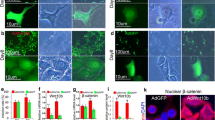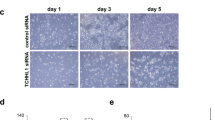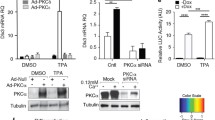Abstract
S100A11, a member of the family of S100 proteins, is a dimmer, each monomer of which has two EF-hands. Expression of S100A11 is ubiquitous in various tissues at different levels, with a high expression level in the skin. We have analyzed functions of S100A11 mainly in normal human keratinocytes (NHK) as a model cell system of human epithelial cells. High Ca2+ and transforming growth factor-β (TGF-β), two representative growth suppressors for NHK, need a common S100A11-mediated pathway in addition to unique pathways (NFAT1-mediated pathway for high Ca2+ and Smad-mediated pathway for TGF-β) for exhibiting a growth inhibitory effect. S100A11 has another action point for growth suppression in NHK. Annexin A1 (ANXA1) complexed with S100A11 efficiently binds to and inhibits cytosolic phospholipase A2 (cPLA2), the activity of which is needed for the growth of NHK. On exposure of NHK to epidermal growth factor (EGF), ANXA1 is cleaved at 12Trp, and this truncated ANXA1 loses binding capacity to S100A11, resulting in maintenance of an active state of cPLA2. On the other hand, we found that S100A11 is actively secreted by NHK. Extracellular S100A11 acts on NHK to enhance the production of EGF family proteins, resulting in growth stimulation. These findings indicate that S100A11 plays a dual role in growth regulation, being suppressive in cells and being promotive from outside of cells.





Similar content being viewed by others
References
Bianchi R, Giambanco I, Arcuri C, Donato R (2003) Subcellular localization of S100A11 (S100C) in LLC-PK1 renal cells: Calcium- and protein kinase c-dependent association of S100A11 with S100B and vimentin intermediate filaments. Microsc Res Tech 60:639–651
Blott EJ, Griffiths GM (2002) Secretory lysosomes. Nat Rev Mol Cell Biol 3:122–131
Broome AM, Eckert RL (2004) Microtubule-dependent redistribution of a cytoplasmic cornified envelope precursor. J Invest Dermatol 122:29–38
Cecil DL, Terkeltaub R (2008) Transamidation by transglutaminase 2 transforms S100A11 calgranulin into a procatabolic cytokine for chondrocytes. J Immunol 180:8378–8385
Cecil DL, Johnson K, Rediske J, Lotz M, Schmidt AM, Terkeltaub R (2005) Inflammation-induced chondrocyte hypertrophy is driven by receptor for advanced glycation end products. J Immunol 175:8296–8302
Cecil DL, Appleton CT, Polewski MD, Mort JS, Schmidt AM, Bendele A, Beier F, Terkeltaub R (2009) The pattern recognition receptor CD36 is a chondrocyte hypertrophy marker associated with suppression of catabolic responses and promotion of repair responses to inflammatory stimuli. J Immunol 182:5024–5031
Chen X, Yeung TK, Wang Z (2000) Enhanced drug resistance in cells coexpressing ErbB2 with EGF receptor or ErbB3. Biochem Biophys Res Commun 277:757–763
Danielsen EM, van Deurs B, Hansen GH (2003) “Nonclassical” secretion of annexin A2 to the lumenal side of the enterocyte brush border membrane. Biochemistry 42:14670–14676
Dempsey AC, Walsh MP, Shaw GS (2003) Unmasking the annexin I interaction from the structure of Apo-S100A11. Structure 11:887–897
Donato R (2007) RAGE: a single receptor for several ligands and different cellular responses: the case of certain S100 proteins. Curr Mol Med 7:711–724
Garcia R, Franklin RA, McCubrey JA (2006) EGF induces cell motility and multi-drug resistance gene expression in breast cancer cells. Cell Cycle 5:2820–2826
Gerke V, Moss SE (2002) Annexins: from structure to function. Physiol Rev 82:331–371
Ghavami S, Rashedi I, Dattilo BM, Eshraghi M, Chazin WJ, Hashemi M, Wesselborg S, Kerkhoff C, Los M (2008) S100A8/A9 at low concentration promotes tumor cell growth via RAGE ligation and MAP kinase-dependent pathway. J Leukoc Biol 83:1484–1492
Hofmann MA, Drury S, Fu C, Qu W, Taguchi A, Lu Y, Avila C, Kambham N, Bierhaus A, Nawroth P, Neurath MF, Slattery T, Beach D, McClary J, Nagashima M, Morser J, Stern D, Schmidt AM (1999) RAGE mediates a novel proinflammatory axis: a central cell surface receptor for S100/calgranulin polypeptides. Cell 97:889–901
Holt OJ, Gallo F, Griffiths GM (2006) Regulating secretory lysosomes. J Biochem 140:7–12
Hori O, Brett J, Slattery T, Cao R, Zhang J, Chen JX, Nagashima M, Lundh ER, Vijay S, Nitecki D et al (1995) The receptor for advanced glycation end products (RAGE) is a cellular binding site for amphoterin mediation of neurite outgrowth and co-expression of rage and amphoterin in the developing nervous system. J Biol Chem 270:25752–25761
Horiuchi S, Unno Y, Usui H, Shikata K, Takaki K, Koito W, Sakamoto Y, Nagai R, Makino K, Sasao A, Wada J, Makino H (2005) Pathological roles of advanced glycation end product receptors SR-A and CD36. Ann N Y Acad Sci 1043:671–675
Hudson BI, Kalea AZ, Del Mar Arriero M, Harja E, Boulanger E, D’Agati V, Schmidt AM (2008) Interaction of the RAGE cytoplasmic domain with diaphanous-1 is required for ligand-stimulated cellular migration through activation of Rac1 and Cdc42. J Biol Chem 283:34457–34468
Inada H, Naka M, Tanaka T, Davey GE, Heizmann CW (1999) Human S100A11 exhibits differential steady-state RNA levels in various tissues and a distinct subcellular localization. Biochem Biophys Res Commun 263:135–138
Jono T, Miyazaki A, Nagai R, Sawamura T, Kitamura T, Horiuchi S (2002) Lectin-like oxidized low density lipoprotein receptor-1 (LOX-1) serves as an endothelial receptor for advanced glycation end products (AGE). FEBS Lett 511:170–174
Keller M, Ruegg A, Werner S, Beer HD (2008) Active caspase-1 is a regulator of unconventional protein secretion. Cell 132:818–831
Kim KM, Kim DK, Park YM, Kim CK, Na DS (1994) Annexin-I inhibits phospholipase A2 by specific interaction, not by substrate depletion. FEBS Lett 343:251–255
Kim S, Ko J, Kim JH, Choi EC, Na DS (2001a) Differential effects of annexins I, II, III, and V on cytosolic phospholipase A2 activity: specific interaction model. FEBS Lett 489:243–248
Kim SW, Rhee HJ, Ko J, Kim YJ, Kim HG, Yang JM, Choi EC, Na DS (2001b) Inhibition of cytosolic phospholipase A2 by annexin I. Specific interaction model and mapping of the interaction site. J Biol Chem 276:15712–15719
Kislinger T, Fu C, Huber B, Qu W, Taguchi A, Du Yan S, Hofmann M, Yan SF, Pischetsrieder M, Stern D, Schmidt AM (1999) N(epsilon)-(carboxymethyl)lysine adducts of proteins are ligands for receptor for advanced glycation end products that activate cell signaling pathways and modulate gene expression. J Biol Chem 274:31740–31749
Kouno T, Mizuguchi M, Sakaguchi M, Makino E, Mori Y, Shinoda H, Aizawa T, Demura M, Huh NH, Kawano K (2008) The structure of S100A11 fragment explains a local structural change induced by phosphorylation. J Pept Sci 14:1129–1138
Lander HM, Tauras JM, Ogiste JS, Hori O, Moss RA, Schmidt AM (1997) Activation of the receptor for advanced glycation end products triggers a p21(ras)-dependent mitogen-activated protein kinase pathway regulated by oxidant stress. J Biol Chem 272:17810–17814
Landriscina M, Soldi R, Bagala C, Micucci I, Bellum S, Tarantini F, Prudovsky I, Maciag T (2001) S100A13 participates in the release of fibroblast growth factor 1 in response to heat shock in vitro. J Biol Chem 276:22544–22552
Leclerc E, Fritz G, Weibel M, Heizmann CW, Galichet A (2007) S100B and S100A6 differentially modulate cell survival by interacting with distinct RAGE (receptor for advanced glycation end products) immunoglobulin domains. J Biol Chem 282:31317–31331
Leclerc E, Fritz G, Vetter SW, Heizmann CW (2009a) Binding of S100 proteins to RAGE: an update. Biochim Biophys Acta 1793:993–1007
Leclerc E, Sturchler E, Vetter SW, Heizmann CW (2009b) Crosstalk between calcium, amyloid beta and the receptor for advanced glycation endproducts in Alzheimer’s disease. Rev Neurosci 20:95–110
Mailliard WS, Haigler HT, Schlaepfer DD (1996) Calcium-dependent binding of S100C to the N-terminal domain of annexin I. J Biol Chem 271:719–725
Mambula SS, Stevenson MA, Ogawa K, Calderwood SK (2007) Mechanisms for Hsp70 secretion: crossing membranes without a leader. Methods 43:168–175
Matsunaga H, Ueda H (2006) Evidence for serum-deprivation-induced co-release of FGF-1 and S100A13 from astrocytes. Neurochem Int 49:294–303
Matsuzawa Y, Kiuchi Y, Toyomura K, Matsumoto I, Nakamura H, Fujino H, Murayama T, Kawashima T (2009) Activation of cytosolic phospholipase A2alpha by epidermal growth factor (EGF) and phorbol ester in HeLa cells: different effects of inhibitors for EGF receptor, protein kinase C, Src, and C-Raf. J Pharmacol Sci 111:182–192
Meyer zu Schwabedissen HE, Grube M, Dreisbach A, Jedlitschky G, Meissner K, Linnemann K, Fusch C, Ritter CA, Volker U, Kroemer HK (2006) Epidermal growth factor-mediated activation of the map kinase cascade results in altered expression and function of ABCG2 (BCRP). Drug Metab Dispos 34:524–533
Moore BW (1965) A soluble protein characteristic of the nervous system. Biochem Biophys Res Commun 19:739–744
Mori M, Shimada H, Gunji Y, Matsubara H, Hayashi H, Nimura Y, Kato M, Takiguchi M, Ochiai T, Seki N (2004) S100A11 gene identified by in-house cDNA microarray as an accurate predictor of lymph node metastases of gastric cancer. Oncol Rep 11:1287–1293
Murzik U, Hemmerich P, Weidtkamp-Peters S, Ulbricht T, Bussen W, Hentschel J, von Eggeling F, Melle C (2008) Rad54B targeting to DNA double-strand break repair sites requires complex formation with S100A11. Mol Biol Cell 19:2926–2935
Naka M, Qing ZX, Sasaki T, Kise H, Tawara I, Hamaguchi S, Tanaka T (1994) Purification and characterization of a novel calcium-binding protein, S100C, from porcine heart. Biochim Biophys Acta 1223:348–353
Nukui T, Ehama R, Sakaguchi M, Sonegawa H, Katagiri C, Hibino T, Huh NH (2008) S100A8/A9, a key mediator for positive feedback growth stimulation of normal human keratinocytes. J Cell Biochem 104:453–464
Ohgami N, Nagai R, Ikemoto M, Arai H, Kuniyasu A, Horiuchi S, Nakayama H (2001a) Cd36, a member of the class b scavenger receptor family, as a receptor for advanced glycation end products. J Biol Chem 276:3195–3202
Ohgami N, Nagai R, Miyazaki A, Ikemoto M, Arai H, Horiuchi S, Nakayama H (2001b) Scavenger receptor class B type I-mediated reverse cholesterol transport is inhibited by advanced glycation end products. J Biol Chem 276:13348–13355
Olsen E, Rasmussen HH, Celis JE (1995) Identification of proteins that are abnormally regulated in differentiated cultured human keratinocytes. Electrophoresis 16:2241–2248
Pardali K, Kurisaki A, Moren A, ten Dijke P, Kardassis D, Moustakas A (2000) Role of Smad proteins and transcription factor Sp1 in p21(Waf1/Cip1) regulation by transforming growth factor-beta. J Biol Chem 275:29244–29256
Pricci F, Leto G, Amadio L, Iacobini C, Romeo G, Cordone S, Gradini R, Barsotti P, Liu FT, Di Mario U, Pugliese G (2000) Role of galectin-3 as a receptor for advanced glycosylation end products. Kidney Int Suppl 77:S31–S39
Prudovsky I, Bagala C, Tarantini F, Mandinova A, Soldi R, Bellum S, Maciag T (2002) The intracellular translocation of the components of the fibroblast growth factor 1 release complex precedes their assembly prior to export. J Cell Biol 158:201–208
Prudovsky I, Tarantini F, Landriscina M, Neivandt D, Soldi R, Kirov A, Small D, Kathir KM, Rajalingam D, Kumar TK (2008) Secretion without Golgi. J Cell Biochem 103:1327–1343
Rauvala H, Rouhiainen A (2007) RAGE as a receptor of HMGB1 (amphoterin): roles in health and disease. Curr Mol Med 7:725–734
Rehman I, Azzouzi AR, Cross SS, Deloulme JC, Catto JW, Wylde N, Larre S, Champigneuille J, Hamdy FC (2004) Dysregulated expression of S100A11 (calgizzarin) in prostate cancer and precursor lesions. Hum Pathol 35:1385–1391
Rety S, Osterloh D, Arie JP, Tabaries S, Seeman J, Russo-Marie F, Gerke V, Lewit-Bentley A (2000) Structural basis of the Ca2+-dependent association between S100C (S100A11) and its target, the N-terminal part of annexin I. Structure 8:175–184
Rintala-Dempsey AC, Rezvanpour A, Shaw GS (2008) S100-annexin complexes—structural insights. Febs J 275:4956–4966
Robinson NA, Lapic S, Welter JF, Eckert RL (1997) S100A11, S100A10, annexin I, desmosomal proteins, small proline-rich proteins, plasminogen activator inhibitor-2, and involucrin are components of the cornified envelope of cultured human epidermal keratinocytes. J Biol Chem 272:12035–12046
Sakaguchi M, Miyazaki M, Inoue Y, Tsuji T, Kouchi H, Tanaka T, Yamada H, Namba M (2000) Relationship between contact inhibition and intranuclear S100C of normal human fibroblasts. J Cell Biol 149:1193–1206
Sakaguchi M, Miyazaki M, Takaishi M, Sakaguchi Y, Makino E, Kataoka N, Yamada H, Namba M, Huh NH (2003) S100C/A11 is a key mediator of Ca2+-induced growth inhibition of human epidermal keratinocytes. J Cell Biol 163:825–835
Sakaguchi M, Miyazaki M, Sonegawa H, Kashiwagi M, Ohba M, Kuroki T, Namba M, Huh NH (2004) PKCalpha mediates TGFbeta-induced growth inhibition of human keratinocytes via phosphorylation of S100C/A11. J Cell Biol 164:979–984
Sakaguchi M, Sonegawa H, Nukui T, Sakaguchi Y, Miyazaki M, Namba M, Huh NH (2005) Bifurcated converging pathways for high Ca2+- and TGFbeta-induced inhibition of growth of normal human keratinocytes. Proc Natl Acad Sci USA 102:13921–13926
Sakaguchi M, Murata H, Sonegawa H, Sakaguchi Y, Futami J, Kitazoe M, Yamada H, Huh NH (2007) Truncation of annexin A1 is a regulatory lever for linking epidermal growth factor signaling with cytosolic phospholipase A2 in normal and malignant squamous epithelial cells. J Biol Chem 282:35679–35686
Sakaguchi M, Sonegawa H, Murata H, Kitazoe M, Futami J, Kataoka K, Yamada H, Huh NH (2008) S100A11, an dual mediator for growth regulation of human keratinocytes. Mol Biol Cell 19:78–85
Salama I, Malone PS, Mihaimeed F, Jones JL (2008) A review of the S100 proteins in cancer. Eur J Surg Oncol 34:357–364
Santini MP, Talora C, Seki T, Bolgan L, Dotto GP (2001) Cross talk among calcineurin, Sp1/Sp3, and NFAT in control of p21(WAF1/CIP1) expression in keratinocyte differentiation. Proc Natl Acad Sci USA 98:9575–9580
Seemann J, Weber K, Gerke V (1997) Annexin I targets S100C to early endosomes. FEBS Lett 413:185–190
Sonegawa H, Nukui T, Li DW, Takaishi M, Sakaguchi M, Huh NH (2007) Involvement of deterioration in S100C/A11-mediated pathway in resistance of human squamous cancer cell lines to TGF beta-induced growth suppression. J Mol Med 85:753–762
Taguchi A, Blood DC, del Toro G, Canet A, Lee DC, Qu W, Tanji N, Lu Y, Lalla E, Fu C, Hofmann MA, Kislinger T, Ingram M, Lu A, Tanaka H, Hori O, Ogawa S, Stern DM, Schmidt AM (2000) Blockade of RAGE-amphoterin signalling suppresses tumour growth and metastases. Nature 405:354–360
Tamura Y, Adachi H, Osuga J, Ohashi K, Yahagi N, Sekiya M, Okazaki H, Tomita S, Iizuka Y, Shimano H, Nagai R, Kimura S, Tsujimoto M, Ishibashi S (2003) FEEL-1 and FEEL-2 are endocytic receptors for advanced glycation end products. J Biol Chem 278:12613–12617
Tanaka M, Adzuma K, Iwami M, Yoshimoto K, Monden Y, Itakura M (1995) Human calgizzarin; one colorectal cancer-related gene selected by a large scale random cDNA sequencing and northern blot analysis. Cancer Lett 89:195–200
Todoroki H, Kobayashi R, Watanabe M, Minami H, Hidaka H (1991) Purification, characterization, and partial sequence analysis of a newly identified EF-hand type 13-kDa Ca2+-binding protein from smooth muscle and non-muscle tissues. J Biol Chem 266:18668–18673
Tu CL, Oda Y, Komuves L, Bikle DD (2004) The role of the calcium-sensing receptor in epidermal differentiation. Cell Calcium 35:265–273
Wein S, Fauroux M, Laffitte J, de Nadai P, Guaini C, Pons F, Comera C (2004) Mediation of annexin 1 secretion by a probenecid-sensitive ABC-transporter in rat inflamed mucosa. Biochem Pharmacol 67:1195–1202
Yan SD, Chen X, Fu J, Chen M, Zhu H, Roher A, Slattery T, Zhao L, Nagashima M, Morser J, Migheli A, Nawroth P, Stern D, Schmidt AM (1996) RAGE and amyloid-beta peptide neurotoxicity in Alzheimer’s disease. Nature 382:685–691
Yeh CH, Sturgis L, Haidacher J, Zhang XN, Sherwood SJ, Bjercke RJ, Juhasz O, Crow MT, Tilton RG, Denner L (2001) Requirement for p38 and p44/p42 mitogen-activated protein kinases in RAGE-mediated nuclear factor-kappaB transcriptional activation and cytokine secretion. Diabetes 50:1495–1504
Zhao XQ, Naka M, Muneyuki M, Tanaka T (2000) Ca2+-dependent inhibition of actin-activated myosin ATPase activity by S100C (S100A11), a novel member of the S100 protein family. Biochem Biophys Res Commun 267:77–79
Acknowledgments
This review partly depends on our studies, which were supported by grants from the Ministry of Health, Labor and Welfare (Research for Intractable Diseases) (N. Huh), from the Ministry of Education, Culture, Sports, Science, and Technology of Japan [Grant-in-Aid for Young Scientists (A)] (M. Sakaguchi), and from Takeda Science Foundation (M. Sakaguchi). We particularly thank our co-workers, Dr. Masayoshi Namba, Dr. Hidenori Yamada, and Dr. Keiichi Kawano.
Author information
Authors and Affiliations
Corresponding author
Rights and permissions
About this article
Cite this article
Sakaguchi, M., Huh, Nh. S100A11, a dual growth regulator of epidermal keratinocytes. Amino Acids 41, 797–807 (2011). https://doi.org/10.1007/s00726-010-0747-4
Received:
Accepted:
Published:
Issue Date:
DOI: https://doi.org/10.1007/s00726-010-0747-4




